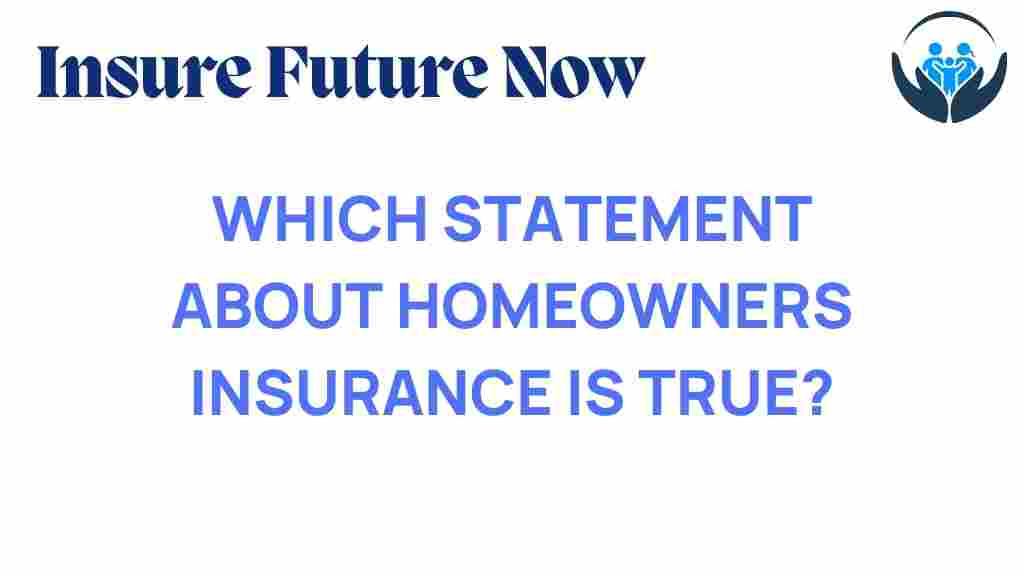Unveiling the Truth: Which Statement About Homeowners Insurance Holds?
When it comes to protecting your home and assets, homeowners insurance is essential. However, many individuals harbor misconceptions about what this type of insurance covers and how it functions. In this article, we will delve into the coverage myths surrounding homeowners insurance, clarify policy truths, and provide important insurance facts that every homeowner should know. Whether you’re a new homeowner or looking to renew your policy, understanding these elements can help you make informed decisions about your home protection.
The Importance of Homeowners Insurance
Homeowners insurance is designed to protect your home and belongings from various risks, including theft, fire, and natural disasters. It also provides liability coverage in case someone is injured on your property. Knowing the ins and outs of your policy can save you time, money, and stress in the long run.
Common Coverage Myths
Let’s explore some common myths surrounding homeowners insurance that can lead to misunderstandings and potentially inadequate coverage:
- Myth 1: Homeowners insurance covers all types of damage.
- Myth 2: You don’t need insurance if your home is paid off.
- Myth 3: Flood damage is included in standard policies.
- Myth 4: All personal belongings are fully covered.
- Myth 5: Filing a claim will automatically raise your premium.
Policy Truths You Should Know
Understanding the realities of your homeowners insurance policy can help you navigate the complexities of your coverage. Here are some essential truths:
- Truth 1: You must have a comprehensive understanding of your policy limits and exclusions.
- Truth 2: Homeowners insurance is crucial for protecting your investment, regardless of whether your home is paid off.
- Truth 3: For flood coverage, you need a separate policy, as it is not included in standard homeowners insurance.
- Truth 4: High-value items may need additional coverage to be fully protected.
- Truth 5: Not all claims lead to increased premiums; it depends on various factors, including your claims history.
Understanding Your Insurance Policy
To fully grasp how your homeowners insurance works, you need to understand several key components of your policy:
- Coverage Types: Familiarize yourself with the different types of coverage included in your policy, such as dwelling coverage, personal property coverage, and liability coverage.
- Exclusions: Know what is not covered by your policy, which can vary from one insurer to another.
- Deductibles: Understand how much you will need to pay out-of-pocket before your insurance kicks in.
- Policy Limits: Be aware of the maximum amount your insurance will pay for covered losses.
The Claims Process: What You Need to Know
Filing a claim can be daunting, but understanding the claims process can simplify the experience. Here’s a step-by-step guide:
- Assess the Damage: Take photos and document all damages for your records.
- Contact Your Insurance Company: Notify them of the incident as soon as possible.
- File a Claim: Follow your insurer’s specific process for filing a claim, which may include filling out forms and providing evidence of the damage.
- Schedule an Inspection: An adjuster will typically come to inspect the damage.
- Receive a Settlement: After the assessment, you will receive an offer based on your policy terms.
Conducting a Risk Assessment
A vital part of managing your homeowners insurance is conducting a risk assessment. This involves evaluating potential hazards that could affect your home. Here are some steps to perform a thorough risk assessment:
- Identify Risks: Look for risks such as fire hazards, security issues, and natural disasters common in your area.
- Evaluate Your Home’s Condition: Regularly check for maintenance issues that could lead to damage.
- Review Your Coverage: Ensure your policy aligns with the risks you’ve identified.
- Update Your Policy as Needed: If your circumstances change, such as renovations or acquiring valuable items, adjust your coverage accordingly.
Understanding Premium Costs
Your premium costs will depend on various factors, including:
- Location: Areas prone to disasters may have higher premiums.
- Home Value: More expensive homes typically incur higher insurance costs.
- Claims History: A history of frequent claims can increase your premium.
- Coverage Amount: Higher coverage limits result in higher premiums.
It’s essential to regularly review and compare quotes from different insurers to ensure you are getting the best deal for your coverage needs.
Troubleshooting Tips for Homeowners Insurance
Here are some troubleshooting tips to help you navigate common issues with homeowners insurance:
- Shop Around: Don’t settle for the first policy you find. Compare multiple quotes to get the best rates.
- Understand Policy Terms: If anything is unclear, ask your insurance agent for clarification.
- Document Everything: Keep thorough records of your belongings and any communication with your insurer.
- Consider Bundling: Many insurance companies offer discounts if you bundle homeowners insurance with auto insurance.
Conclusion
As you can see, navigating the world of homeowners insurance can be complex, filled with coverage myths and policy truths that can confuse even the most diligent homeowner. By educating yourself on these insurance facts, understanding your policy, and knowing the claims process, you can ensure that you are adequately protected against potential risks.
Remember, protecting your home is about more than just having insurance; it’s about making informed choices that safeguard your investment. For more information on homeowners insurance and how to choose the right policy for you, consider visiting NAIOP for valuable resources.
For further assistance or personal advice regarding your insurance needs, feel free to reach out through our contact page.
This article is in the category Coverage and created by InsureFutureNow Team
